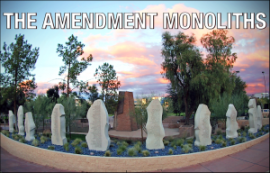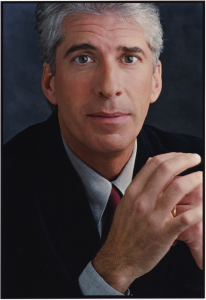Bill of Rights: A National Blueprint for Monuments

On the eastern side of the Oklahoma State Capitol Building lies a semi-circle stretch of road. Two oak trees and a bush, layered by ragweed and white flowers, sit in the median. Since its beginning, the space has served no purpose other than to block the main road from the steps of the capitol.
As of September 18, 2017, the location will serve as the future site of a Bill of Rights monument.
Chris Bliss is the executive director of the Bill of Rights Monument Project. He believes the country needs the monument now more than ever.
“The Bill of Rights is something that is more important now as we come to a crossroads in our nation’s history,” he said. “It brings people together not just for contemplation but also for a conversation.”
The Bill of Rights Monument Project is a nonprofit organization with the intent of placing a monument dedicated to the Bill of Rights on each State Capital of the United States.

While the project is being organized in Oklahoma, Arizona is the home of the first monument built by the organization. As of 2017, Alabama and Texas have been approved to be the next locations. California has announced in 2018 they will provide a hearing for the organization.
“What you’d have is millions of school kids every year for the next few hundred years seeing the Bill of Rights as an iconic document and their first experience directly dealing with governance and democracy and how it works,” Bliss said.
Bliss went on to say, “the ones that get it will most likely end up in the capitol trying to make a difference.”
Once construction is complete, it will be the second monument of its kind. The first one was dedicated on December 15, 2012 in Arizona after five years of planning and construction. Bliss says half of the time was meant for a learning curve. The other half was due to the Arizona legislature.
Arizona’s monument consists of 10 limestone monoliths, each seven – and – a – half feet tall. The limestone is expected to last over one hundred years. Bliss emphasized the differences in design for each state’s location.
“Every state would be different because every site is different,” he said. “Good design has to be site specific.”
The estimated cost for the monument is $850,000. The first step, Bliss said, is to raise $100,000.
Feedback has been positive. Gary Banz, a former State Representative from Midwest City, is one of the principal authors of the legislation. Banz said he is focusing on something the American people can rally behind.
“The Bill of Rights is foundational to the experience of self-government in our republic based on democratic principles,” he said.
Retired Major General Rita Aragon is the former Secretary of Veteran Affairs for Governor Mary Fallin. Aragon believes the Bill of Rights “defines us as a nation.”
“These are the freedoms countless Americans have fought and died to protect,” she said.
Many residents see a movement to represent the Bill of Rights as refreshing. Frankie Gonzalez, a freshman at Oklahoma City Community College, remembers when the legislature placed a monument to the 10 Commandments at the foot of the Capitol. This occurred in late 2012. After many complaints and lawsuits, it was removed in 2015.
“To hear that they’re placing something as representative as the Bill of Rights instead of the 10 Commandments is something that makes me hopeful for Oklahoma,” Gonzalez said. “This is something that doesn’t include just one group or another; it brings us all closer if we listen to it.”
The Bill of Rights Monument Project is accepting contributions from those who want to help see the monument built within the next two years. In September, Anheuser-Busch announced it is donating $25,000.
Bliss continues to work towards making the project a nationwide effort. He wishes to make the Bill of Rights the most nationally accessible monument.

“I’m a believer in the power of idea and it’s undoubtedly why I got started on this,” Bliss said. “It’s a powerful set of ideas if you think about less than 500 words and it basically sets up the entire blueprint of free, just and civil society. It’s pretty remarkable.”
If you wish to donate, go to the link below and click on “Donate.”
http://mybillofrights.org/